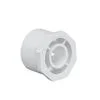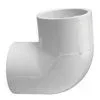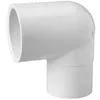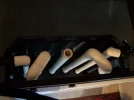Kizmar
#derpface
Having just gone through this excercise, I wanted to share how I made my overflow standpipes.
First, what am I talking about?
Traditional overflow systems allow the water to fall the height of the tank before going down the drain to the sump. This can be loud and give you the urge to pee every time you enter the room.
To quiet the flow, you would use a standpipe (like the ever-so-popular Durso Standpipe). A standpipe will raise the level of water in the overflow area so the water only falls a couple inches instead of a foot or two.
How can I make one cheap?
What you'll need (this is all schedule 40 PVC):




Make a candy cane shape with the pipe and the two elbows. The pipe length can be what ever you need to raise the water level in your overflows.
Put the bushing on the bottom of the candy cane shape and a 2" piece of 3/4" PVC in the bushing. The 3/4" PVC on the bottom should fit into your bulkhead. * This part will vary based on the size of your bulkhead opening. I didn't glue any of my pieces together, it's not needed.
Drilling the holes - the make or break part of this!
Once it's all put together, drill a 1/4" hole in the very top center of the candy cane. This should be the highest point when it's standing up. This is the siphon hole (draws in air).
Next, drill a 1/2" hole on each side of the 1 1/4" PVC about 3/4" down from where the elbow connects.
This should allow for proper flow and stop your standpipe from gurgling and whistling. If it IS whistling, I've ready that you want to slowly increase the size of the siphon hole. I didn't have to for mine, but that probably depends on the amount of water flow you have.
Had I thought about posting this before I installed them I'd take a picture of mine, but it's too much of a pain in my ass to get them in and out (because of the return loc-lines).
I went through a couple iterations of holes in the elbows thinking that more holes would be good but that's not the case. This is the most quiet method I've found. It's so quiet that, unless you knew what to listen for, you probably wouldn't notice it at all.
First, what am I talking about?
Traditional overflow systems allow the water to fall the height of the tank before going down the drain to the sump. This can be loud and give you the urge to pee every time you enter the room.
To quiet the flow, you would use a standpipe (like the ever-so-popular Durso Standpipe). A standpipe will raise the level of water in the overflow area so the water only falls a couple inches instead of a foot or two.
How can I make one cheap?
What you'll need (this is all schedule 40 PVC):
- A length of 1 1/4" PVC tubing (how ever much you'll need, I think they sell them in 5' lengths)
- 2 x 90 degree elbows
- 2 x 90 degree elbows with a slip side
- 2 x 1 1/4" to 3/4" bushing (the second size should match your bulkhead hole)
- 2 x 2" lengths of 3/4" PVC (this should match your bulkhead hole)




Make a candy cane shape with the pipe and the two elbows. The pipe length can be what ever you need to raise the water level in your overflows.
Put the bushing on the bottom of the candy cane shape and a 2" piece of 3/4" PVC in the bushing. The 3/4" PVC on the bottom should fit into your bulkhead. * This part will vary based on the size of your bulkhead opening. I didn't glue any of my pieces together, it's not needed.
Drilling the holes - the make or break part of this!
Once it's all put together, drill a 1/4" hole in the very top center of the candy cane. This should be the highest point when it's standing up. This is the siphon hole (draws in air).
Next, drill a 1/2" hole on each side of the 1 1/4" PVC about 3/4" down from where the elbow connects.
This should allow for proper flow and stop your standpipe from gurgling and whistling. If it IS whistling, I've ready that you want to slowly increase the size of the siphon hole. I didn't have to for mine, but that probably depends on the amount of water flow you have.
Had I thought about posting this before I installed them I'd take a picture of mine, but it's too much of a pain in my ass to get them in and out (because of the return loc-lines).
I went through a couple iterations of holes in the elbows thinking that more holes would be good but that's not the case. This is the most quiet method I've found. It's so quiet that, unless you knew what to listen for, you probably wouldn't notice it at all.



